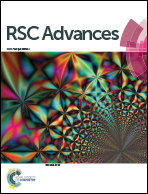Nitrogen-doped carbon coated SiO nanoparticles Co-modified with nitrogen-doped graphene as a superior anode material for lithium-ion batteries†
Abstract
One great challenge in the development of lithium-ion batteries is to simultaneously achieve superior reversible specific capacity, cyclic life and rate capability. In this work, nitrogen-doped carbon coated Silicon monoxide nanoparticles further co-modified with nitrogen-doped graphene were developed. The nanostructure of Silicon monoxide was designed and realized by introducing the highly efficient attritor mill technique, which assisted in forming optimized morphology and particle size distributions of the precursor. The nitrogen-doped carbon coating process was achieved by a simple surface coating technique using a carbon and nitrogen containing ionic liquid as a precursor, and the nitrogen-doped graphene was prepared by a facile, catalyst-free thermal annealing approach using low-cost industrial material melamine as the nitrogen source. XRD, XPS, RAMAN, FESEM, EDAX, TEM, HRTEM, AFM, BET, elemental analysis, electrical conductivity measurement and electrochemical methods were used to characterize the material's properties. The results showed that the reduced active particle size, coupled with the co-modification of the NC coating layer and NG network could effectively construct a 3D conducting network through a 3D “sheet-web” mode. As a result, the composite material showed exceptional high reversible specific capacity, ultra long cyclic life and superior high-rate capability. The present strategy opens up the possibility for integrating other anode materials with large volume variations and low electrical conductivities into current lithium-ion battery manufacture technology.


 Please wait while we load your content...
Please wait while we load your content...